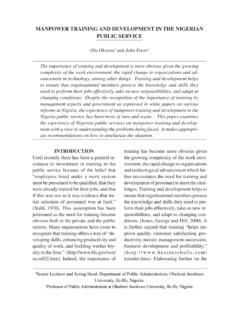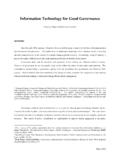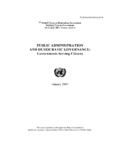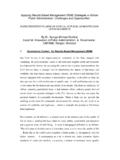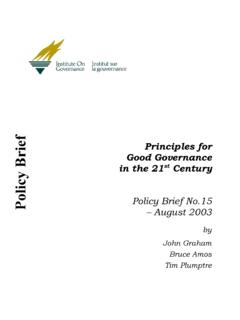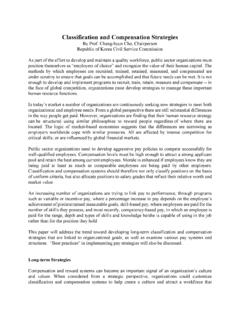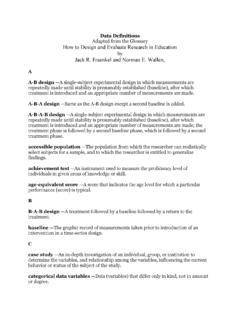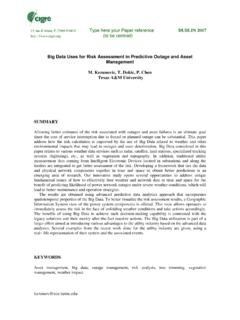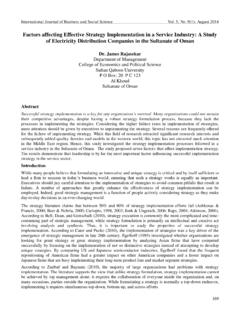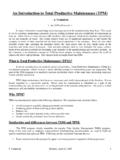Transcription of AFRICAN ASSOCIATION FOR PUBLIC - United Nations
1 AFRICAN ASSOCIATION FOR PUBLIC . ADMINISTRATION AND MANAGEMENT. 27TH AAPAM ANNUAL ROUNDTABLE CONFERENCE, ZAMBEZI SUN HOTEL, LIVINGSTONE, ZAMBIA. 5TH 9TH DECEMBER 2005. THEME: HARNESSING THE PARTNERSHIP OF THE PUBLIC AND. NON-STATE SECTORS FOR SUSTAINABLE DEVELOPMENT AND. GOOD GOVERNANCE IN AFRICA: PROBLEMS AND THE WAY. FORWARD. TOPIC: POLICY implementation : LESSONS FOR SERVICE DELIVERY. By: Prof. Petrus A. Brynard School of PUBLIC Management and Administration, University of Pretoria Abstract This paper focuses on key issues regarding the implementation of policy and service delivery in the South AFRICAN PUBLIC sector. The purpose of the paper is to clarify concepts, to identify key variables for implementation .
2 The challenge is to analytically appreciate the resulting complexity of implementation . Like so much of the literature on domestic implementation , implementation could be considered to be intrinsically complex. Although one expects all implementation to be dynamic and complex, not every episode of implementation is likely to be equally complex. Depending on particular situations some variables are likely to be more manifestly complex in some situations than in others. Also, the set of variables proposed in this paper is, in fact, more parsimonious than many alternative sets. The complexity is not as much in the breadth of the variables as in their depth.
3 Unravelling that complexity is imperative to unravelling implementation effectiveness and therefore successful service delivery. The opportunity is to use the five Cs strategically in their complex interlinkages to synergise implementation . 2. Introduction South Africa in a policy context went through a major review of policies especially during 1995 to 1996. This is the so-called White Paper Era'. This period was followed by a phase of particular emphasis on service delivery (1997 to 2003) with a renewed focus on implementation by President Thabo Mbeki. In recent times much attention has also been paid to service delivery, especially in the sphere of local government.
4 There are currently ample examples in the media on service delivery or the lack of it. Service delivery is also linked to policy and policy implementation . The question is how one enhances policy implementation strategies to ensure successful service delivery. Policy development, implementation and service delivery therefore need to be consolidated so that a more coherent policy and strategy system with ongoing review and performance management mechanisms are developed. Policy implementation and service delivery are critical for both the PUBLIC and private sectors. Currently there are also ample examples in both these sectors in the media.
5 However, the media focus is predominantly on service delivery and not so much on policy implementation . The specific usage of concepts like, policy, strategy and service delivery might also have different meanings in the PUBLIC and private sector. In this paper the emphasis will mainly be on the PUBLIC sector perspective and interpretation. This paper will briefly review some commonly known approaches to policy implementation followed by a section on critical variables for implementation . These variables, partly or wholly , prove to be vital for the policy implementation challenges in South Africa. 3. 2 The meaning of policy implementation Pressman and Wildavsky (1973) uncovered many surprises and unmasked many myths.
6 One of these concerned the literature on the subject: There is (or there must be) a large literature about implementation in the social sciences- or so we have been told by numerous It must be there; it should be there; but in fact it is not. There is a kind of semantic illusion at work here because everything ever done in PUBLIC policy or PUBLIC administration must, in the nature of things, have some bearing on Nevertheless, excect for the few pieces mentioned in the body of this book, we have been unable to find any significant analytic work dealing with implementation (Pressman and Wildavsky,1973: 166). Although the United States of America and Western Europe have passed through different phases of policy implementation research, South Africa is currently in the midst of the implementation era.
7 Scholars, like Wildavsky (1973) already started in the sixties and the seventies with implementation research; however, a common theory is still lacking. There is still some confusion regarding the beginning of implementation , when it ends, and how many types of implementation there are. implementation , according to Pressman and Wildavsky (1973: xiii-xv), "means just what Webster [dictionary] and Roget [thesaurus] say it does: to carry out, accomplish, fulfill, produce, complete." According to their seminal book on the subject: "Policies imply Policies become programs when, by authoritative action, the initial conditions are implementation , then, is the ability to forge subsequent links in the causal chain so as to obtain the desired result.
8 ". A more specific definition is provided by Van Meter and Van Horn (1974: 447-8): "Policy implementation encompasses those actions by PUBLIC or private individuals (or groups) that are directed at the achievement of objectives set forth in prior policy decisions." They make a clear distinction between the interrelated concepts of implementation , performance, impact and stress. 4. The observation is that impact studies typically ask "What happened?" whereas implementation studies ask "Why did it happen?". A widely accepted model of the causal processes of implementation still remains, what Hargrove (1975) had called the "missing link" in social policy studies.
9 It could be pointed out that: implementation research has been too restricted in time ( , an emphasis on cross-sectional versus longitudinal analysis), too restricted in number ( , an emphasis on case study versus comparative analyses), too restricted in policy type ( , an emphasis on single policy type versus multiple policy types), too restricted in defining the concept of implementation ( , limited to a single output measure versus multiple measures), and too restricted in approach ( , the utilization of either "top-down" or "bottom-up" approach versus both). Having said that, the literature has, in fact, come a long way in highlighting the inevitable complexity of the implementation process and the saliency of trying to understand this complexity.
10 5. 3 Three generations of research into implementation Research into implementation has evolved over the last twenty years. The literature on implementation is arbitrary not necessarily in any sequence, but there are certain highlights that can be identified. Three generations of research into policy implementation exists. The very first or classical generation of thinking on the subject began with the assumption that implementation would happen 'automatically' once the appropriate policies had been authoritatively proclaimed. The second generation set out to challenge this assumption, to explain implementation 'failure'.

